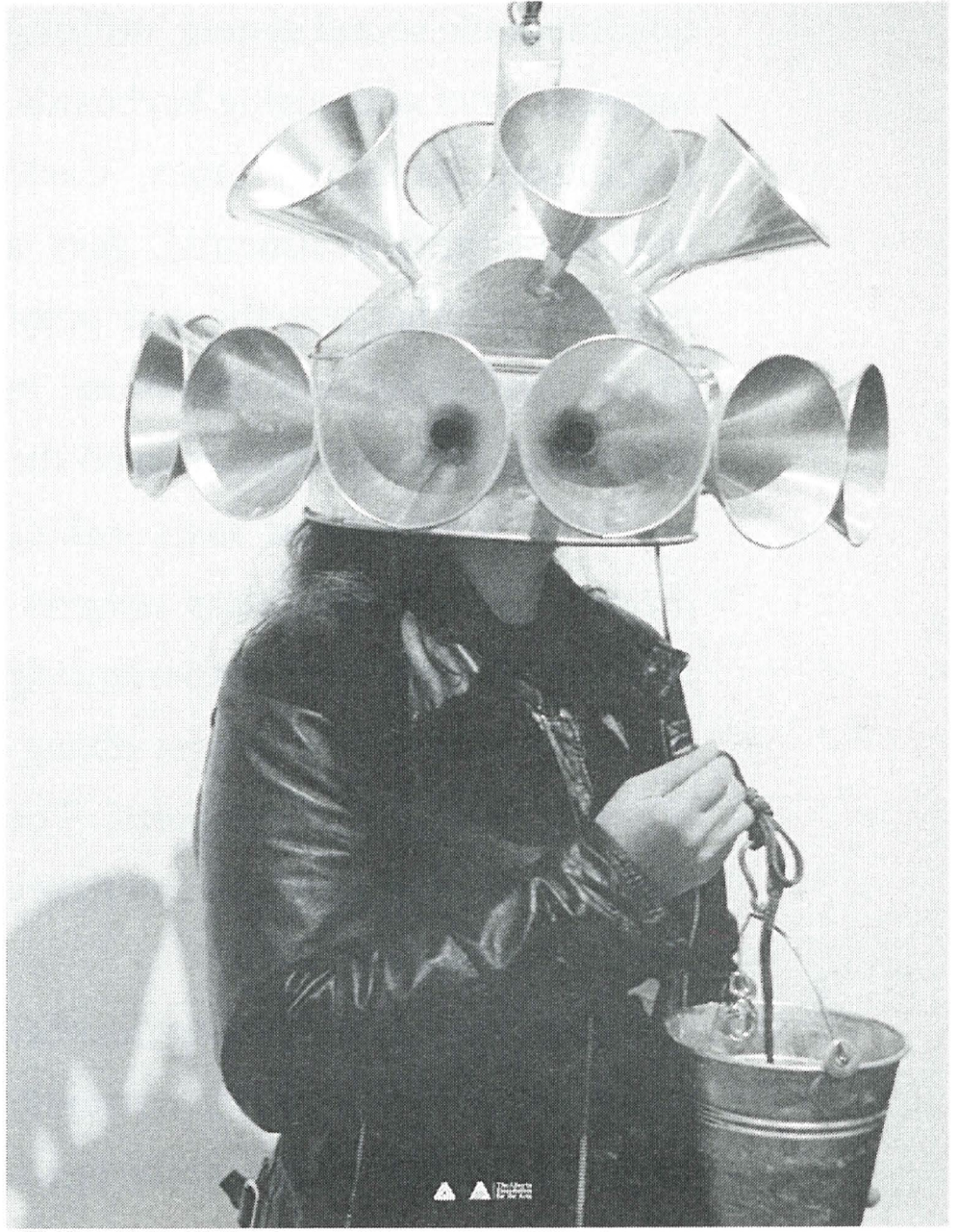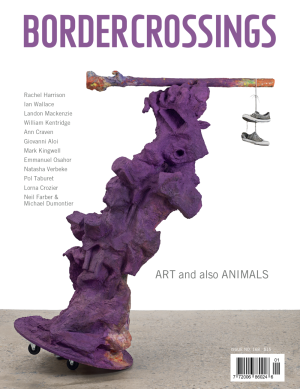Sounding Off
Organized by Steve Bates, program director at University of Winnipegs radio CKUW, “send + receive” was Video Pools first full-scale international festival of sound and one of its most comprehensive audio projects to date. It came fast on the heels of the release of “VP on CD” (ten years of Video Pool audio artists-in-residence) and the recent introduction of audio works into its distribution program. “send + receive” was timely and ambitious, including an evening of performance, a week-long installation component and 8O-minute screening of sound-based video curated by Robert Sauvey.
The performance evening, in the acoustically challenged Bulman Centre at the University of Winnipeg, was varied and demanding and might better have been spread over two nights. The audience thinned later in the evening less from lack of interest than from audio overload, a testament to the energy and complexity of the earlier performances. Seven hours is a long time to mill about or sit on a concrete floor regardless of how strong the programming is. The organizer’s desire to cover all the bases may have exceeded the audience’s ability to absorb the sound offerings made. This was disappointing, since it left late night performers, like virtuoso turntablist Martin Tetreault and D.J. Honeycut, with unjustly small (though appreciative) audiences.
The evening of live audio performance began with pure human voice. Humming Experiments, a Winnipeg group that records and overdubs humming in various architectural/acoustic environments and collaborates with a fellow group of hummers in Ireland, did a gentle opening improvisation. They were followed by Kathy Kennedy’s playful, high-energy vocal experiments. Kennedy is willing and able to go anywhere and she completely broke through the conceptual distance between audience and performer, jogging through the crowd to alter her breathing and vocally ‘jamming’ on headlines from the daily news. Her inclination to reference every possible source makes her an ambassador of how sound art has developed out of music and performance in this century. She was the right choice to introduce the evening.
Michael Dumontier (a member of the Royal Art Lodge) and Todd Martin played three sets called dropping is louder than lifting using an unorthodox inventory of found objects, including record players, records, fishing line and 8-track players, cassette tapes, and spooling and adding machines. These were fascinating performances, since watching these kinetic do-it-yourselfer sound machines being played is as curious as listening to them. Dumontier and Martin’s reconstruction of cassette decks and record players into musical instruments is a departure from sonic ‘cut and paste’ that so thoroughly transforms the source audio as to make it admirably unrecognizable.
Ken Gregory, Shawn Pinchbeck and Steve Heimbecker, who have previously collaborated (using a quadraphonic sound system, utilizing samplers, MIDI and analog keyboards, Macintosh computer, tapes, Casio MIDI horn, and treatments), gave a performance that was the end point of a week-long collaboration in Winnipeg. The audience roamed the complex quadrophenic sonic waking dream trance ambient sleep compression capsule, everyone experiencing the work differently in ever-changing relation to the speakers. The result was a totally mesmerizing sonic environment.

The Acoustic Field Intensifier, 1993-1994, galvanized 10L fuel funnel, 21 galvanized 1L funnels, galvanized 2L pail, rope, 61 x 61
David Grubbs, a founding member of Gastr del Sol (who is currently with The Red Krayola), was the headlining act. His set was less overtly experimental than had been expected, returning to the roots of folk music as storytelling. (Grubbs is a PhD candidate in literature at the University of Chicago.) In context, the set seemed anti-climactic. Had he been able to play an evening on his own, his intimate acoustic magic and brilliant guitar-playing might have been better served.
Grubbs was followed by Martin Tetreault, the turntablist from Montreal whose intensity and artful manipulation of vinyl recordings brought everybody to their feet and up close to the stage to witness his own special blend of sonic alchemy A dance set by D.J. Honeycut followed, who performed admirably—he was there to have fun—despite the pretty thin early morning crowd.
The installation segment of the festival was much lower-key. Installations were housed in a series of small rooms around the periphery of the open performance space. France’s Theophile Billich’s The Campaign, Legislative, may 1997 consisted of ten earphones stuck to a piece of flypaper which transmitted the campaign speeches of ten candidates in a French election. Film and sound-maker Greg Hanec, with Campbell Martin, projected film loops with sound through a glass wall creating a subtle backdrop to the performance evening. Hanec works with film clips like a turntablist works with records, using random multiple projections from film-as-cultural-history to build bizarre critical and poetic juxtapositions. The Wax Museum, a CD ROM based on the world of bees, by Richard Dyck, Aganetha Dyck and William Eakin was also accessible throughout the week. It can take hours to play all the possibilities of this visually gorgeous, maze-like project. Ken Gregory’s sound-as-environment radio intervention under the influence of ether, an atmospheric two-watt FM computer-generated broadcast, infused the immediate neighbourhood with ambient tides of electronic waves. Steve Heimbecker’s absurdist, interactive audio sculpture, The Kakaphonia, suggested dadaist non-sensibilities with its three brightly coloured electro-towers wired to a computer keyboard: each key was set to turn on an individual radio tuned to everything from white noise to country music.
What the festival sorely lacked was a symposium. The questions people had before and after the performances—how do these audio works fit into the idea of a sound culture? what is a sound culture?—were left unanswered. On an academic level more and more study is being devoted to exploring the position of sound in culture. The World Federation of Acoustic Ecology maintains we are a noise producing society. As a result, the World Health Organization now releases the daily level of audio pollutants. Sound is all around us. When we sleep our closed eyelids can block out light but we don’t have earlids to block out sound. Sound can be used as a raw material in creating an aural equivalent of any artistic process. By focussing on imaginative sonic works, in an increasingly visual culture, audio artists hope to build an awareness of the importance of the skill of listening. Despite the demise of Co-op Radio, and the early ’90s audio collective ARAD, Winnipeg’s extremely active core of sound artists and collaborators have high hopes that the festival will continue on an annual basis. Aside from some first-festival growing pains, “send + receive” intends to be a major contributor to an increased sound awareness. It was a long-awaited delight for sore ears. ♦
“send + receive,” a festival of sound was presented by Video Pool from November 20 to 27, 1998 at the University of Winnipeg’s Bulman Centre.
Susan Chafe is a Winnipeg artist and book designer. Ken Gregory is a Winnipeg audio artist.

